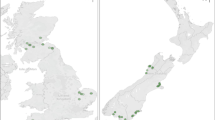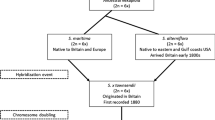Abstract
The enemy release hypothesis predicts that invasive plant species may benefit from a lack of top-down control by co-evolved herbivores, particularly specialists, in their new range. However, to benefit from enemy escape, invasive plants must also escape or resist specialist or generalist herbivores that attack related species in the introduced range. We compared insect herbivore damage on the exotic shrub, Lonicera maackii, the native congener Lonicera reticulata, and the native confamilial Viburnum prunifolium in North America. We also compared the laboratory preference and performance of a North American honeysuckle specialist sawfly (Zaraea inflata) and the performance of a widespread generalist caterpillar (Spodoptera frugiperda) on cut foliage from native and exotic Lonicera species. L. maackii received significantly lower amounts of foliar herbivory than L. reticulata across three seasons, while damage levels observed on V. prunifolium for two seasons was generally intermediate between L. reticulata and L. maackii. The specialist sawfly damaged L. reticulata heavily, but was not detected on L. maackii in the field. There were few statistical differences in the performance of sawfly larvae on L. reticulata and L. maackii, but the sawfly achieved higher pupal masses on L. reticulata than on L. maackii, and they strongly preferred L. reticulata over L. maackii when given a choice. The sawfly was unable to complete development on native L. sempervirens and non-native L. japonica. In contrast, the generalist caterpillar performed similarly on all Lonicera species. While L. maackii experienced little herbivory in the field compared to native relatives in the same habitat, laboratory assays indicate L. maackii appears to be a suitable host that escapes selection by the specialist, but L. japonica and L. sempervirens are highly resistant to it. These findings indicate that both enemy escape and resistance (to a specialist, but not a generalist herbivore) may contribute to the success of exotic Lonicera species.



Similar content being viewed by others
References
Adams JM, Fang W, Callaway RM, Cipollini D, Newell E (2009) A cross-continental test of enemy release hypothesis: leaf herbivory on Acer platanoides (L.) is three times lower in North America than in its native Europe. Biol Invasions 11:1005–1016
Afkham ME, Rudgers JA (2009) Endophyte-mediated resistance to herbivores depends on herbivore identity in the wild grass Festuca subverticillata. Environ Entomol 38:1086–1095
Agrawal AA, Kotanen PM, Mitchell CE, Power AG, Godsoe W, Klironomos J (2005) Enemy release? An experiment with congeneric plant pairs and diverse above- and below-ground enemies. Ecology 86:2979–2989
Alves MN, Sartoratto A, Trigo JR (2007) Scopolamine in Brugmansia suaveolens (Solanaceae): defense, allocation, costs, and induced response. J Chem Ecol 33:297–309
Ashton IW, Lerdau MT (2008) Tolerance to herbivory, and not resistance, may explain differential success of invasive, naturalized, and native North American temperate vines. Diversity Distrib 14:169–178
Barker A, Schaffner U, Boevé JL (2002) Host specificity and host recognition in a chemically-defended herbivore the tenthredinid sawfly Rhadinoceraea nodicornis. Entomol Exp Appl 104:61–68
Bernays EA, Minkenberg OPJM (1997) Insect herbivores: different reasons for being a generalist. Ecology 78:1157–1169
Blossey B, Nötzold R (1995) Evolution of increased competitive ability in invasive nonindigenous plants: a hypothesis. J Ecol 83:887–889
Callaway RM, Ridenour WM (2004) Novel weapons: invasive success and the evolution of increased competitive ability. Front Ecol Environ 2:436–443
Cappuccino N, Arnason JT (2006) Novel chemistry of invasive exotic plants. Biol Lett 2:189–193
Catford JA, Jansson R, Nilsson C (2009) Reducing redundancy in invasion ecology by integrating hypotheses into a single theoretical framework. Divers Dist 15:22–40
Cipollini D, Stevenson R, Cipollini K (2008a) Contrasting effects of allelochemicals from two invasive plants on the performance of a nonmycorrhizal plant. Int J Plant Sci 169:371–375
Cipollini D, Stevenson R, Enright S, Eyles A, Bonello P (2008b) Phenolic metabolites in leaves of the invasive shrub, Lonicera maackii, and their potential phytotoxic and anti-herbivore effects. J Chem Ecol 34:144–152
Cogni R (2010) Resistance to plant invasion? A native specialist herbivore shows a preference for and higher fitness on an introduced host. Biotropica 42:188–193
Coley PD (1983) Herbivory and defensive characteristics of tree species in a lowland tropical forest. Ecol Monogr 53:209–234
Cripps MG, Schwarzlander M, McKenney JL, Hinz HL, Price WJ (2006) Biogeographical comparison of the arthropod herbivore communities associated with Lepidium draba in its native, expanded and introduced ranges. J Biogeogr 33:2107–2119
Dewalt SJ, Denslow JS, Ickes K (2004) Natural enemy release facilitates habitat expansion of the invasive tropical shrub Clidemia hirta. Ecology 85:471–483
Dorning M, Cipollini D (2006) Leaf and root extracts of the invasive shrub, Lonicera maackii, inhibit seed germination of three herbs with no autotoxic effects. Plant Ecol 184:287–296
Ebeling SK, Hensen I, Auge H (2008) The invasive shrub Buddleja davidii performs better in its introduced range. Divers Distrib 14:225–233
Hartley MK, Rogers WE, Siemann E (2010) Comparisons of arthropod assemblages on an invasive and native trees: abundance, diversity, and damage. Arthropod Plant Interact 4:237–245
Hill SR (2003a) Conservation assessment for yellow honeysuckle (Lonicera flava) Sims. USDA Forest Service, Eastern Region: http://www.fs.fed.us/r9/wildlife/tes/ca-overview/docs/plant_Lonicera-flava-Red_Honeysuckle.pdf
Hill SR (2003b) Conservation assessment for red honeysuckle (Lonicera dioica) L. ‘var.glaucescens (Rydb.) Butters’) Center for Biodiversity Technical Report 2003 (12) Illinois Natural History Survey 607 East Peabody Drive Champaign, Illinois 61820 Prepared for: U.S.D.A., Forest Service Vienna Ranger District Shawnee National Forest P. O. Box 37 Vienna, IL 62995 31 March 2003
Hutchinson TF, Vancat JL (1998) Landscape Structure and Spread of the Exotic Shrub Lonicera maackii (Amur honeysuckle) in Southwestern Ohio Forests. Am Midl Nat 139:383–390
Ingold JL, Craycraft MJ (1983) Avian frugivory on honeysuckle (Lonicera) in Southwestern Ohio in fall. Ohio J Sci 83:256–258
Jahner JP, Bonilla MM, Badik KJ, Shapiro AM, Forister ML (2011) Use of exotic hosts by Lepidoptera: widespread species colonize more novel hosts. Evolution 65:2719–2724
Joshi J, Vrieling K (2005) The enemy release and EICA hypothesis revisited: incorporating the fundamental difference between specialist and generalist herbivores. Ecol Lett 8:704–714
Kartesz JT, Meacham (1999) Synthesis of the North American flora. Version 1.0. CD-ROM. Biota of North America Program, North Carolina Botanical Garden, Chapel Hill
Keane RM, Crawley MJ (2002) Exotic plant invasions and the enemy release hypothesis. Trends Ecol Evol 17:164–170
Lankau RA, Rogers WE, Siemann E (2004) Constraints on the utilization of the invasive Chinese tallow tree Sapium sebiferum by generalist native herbivores in coastal prairies. Ecol Entomol 29:66–75
Lieurance D (2004) Leaf phenology, fecundity, and biomass allocation of the invasive shrub Lonicera maackii (rupr.) maxim in contrasting light environments. Masters thesis, Ohio University
Lieurance D, Cipollini D (2012) Damage levels from arthropod herbivores on Lonicera maackii suggest enemy release in its introduced range. Biol Invasions 14:863–873
Liu H, Stiling P (2006) Testing the enemy release hypothesis: a review and meta-analysis. Biol Invasions 8:1535–1545
Liu H, Stiling P, Pemberton RW (2007) Does enemy release matter for invasive plants? Evidence from a comparison of insect herbivore damage among invasive, non-invasive and native congeners. Biol Invasions 9:773–781
Luginbill P (1928) The fall armyworm. USDA Tech Bull No 34 92
Luken JO, Thieret JW (1996) Amur honeysuckle, its fall from grace. Bioscience 46:18–24
Luken JO, Kuddes LM, Tholemeier TC, Haller DM (1997) Comparative responses of Lonicera maackii (Amur honeysuckle) and Lindera benzoin (spicebush) to increased light. Am Midl Nat 138:331–343
McEwan RW, Birchfield MK, Schoergendorfer A, Arthur MA (2009) Leaf phenology and freeze tolerance of the invasive shrub Amur honeysuckle and potential native competitors. J Torrey Bot Soc 136:212–220
McEwan RW, Arthur-Paratley LG, Rieske LK, Arthur MA (2010) A multi-assay comparison of seed germination inhibition by Lonicera maackii and co-occurring native shrubs. Flora 205:475–483
MiddleKauff WW (1956) A Cimbicid sawfly feeding on an ornamental honeysuckle. J Econ Ent 49:701–702
Mitchell CE, Agrawal AA, Bever JD, Gilbert GS, Hufbauer RA, Klironomos JN, Maron JL, Morris WF, Parker IM, Power AG, Seabloom EW, Torchin ME, Vazquez DP (2006) Biotic interactions and plant invasion. Ecol Lett 9:726–740
Morrison WE, Hay ME (2011) Herbivore preference for native vs. exotic plants: generalist herbivores from multiple continents prefer exotic plants that are evolutionarily naïve. Plos One 6. doi:10.1371/journal.pone.0017227
Parker JD, Hay ME (2005) Biotic resistance to plant invasions? Native herbivores prefer non-native plants. Ecol Lett 8:959–967
Poorter L, Bongers F (2006) Leaf traits are good predictors of plant performance across 53 rain forest species. Ecology 87:1733–1743
Roininen H, Tahvanainen J (1989) Host selection and larval performance of two willow-feeding sawflies. Ecology 70:129–136
Schaffner U, Ridenour WM, Wolf VC, Bassett T, Muller C, Muller-Scharer H, Sutherland S, Lortie CJ, Callaway RM (2011) Plant invasions, generalist herbivores, and novel defense weapons. Ecology 92:829–835
Schierenbeck KA (2004) Japanese Honeysuckle (Lonicera japonica) as an invasive species; history, ecology, and context. Crit Rev Plant Sci 23:391–400
Schierenbeck KA, Mack RN, Sharitz RR (1994) Effects of herbivory on growth and biomass allocation in native and introduced species of Lonicera. Ecology 75:1661–1672
Schmidt KA, Whelan CJ (2001) Effects of exotic Lonicera and Rhamnus on songbird nest predation. Conserv Biol 13:1502–1506
Shang XF, Pan H, Li MX, Miao XL, Ding H (2011) Lonicera japonica Thunb. Ethnopharmacology, phytochemistry, and pharmacology of an important traditional Chinese medicine. J Ethnopharmacol 138:1–21
Siemann E, Rogers WE (2003) Herbivory, disease, recruitment limitation, and success of alien and native tree species. Ecology 84:1489–1505
Singer MC, Thomas CD, Parmesan C (1993) Rapid human-induced evolution of insect host associations. Nature 366:681–683
Skullman BW, Mattice JD, Cain MD, Gbur EE (2004) Evidence for allelopathic interference of Japanese honeysuckle (Lonicera japonica) to loblolly and shortleaf pine regeneration. Weed Sci 52:433–439
Sparks AN (1979) A review of the biology of the fall armyworm. Florida Entomol 62:82–87
Theis N, Donoghue MJ, Li J (2008) Phylogenetics of the Caprifoliaceae and Lonicera (Dipscales) based on nuclear and chloroplast DNA sequences. Syst Botany 33:776–783
Trisel DE (1997) The invasive shrub Lonicera maackii (Rupr.) Herder (Caprifoliaceae); factors contributing to its success and its effect on native species. Dissertation, Miami University
Verhoeven KJF, Biere A, Harvey JA, Van der Putten WH (2009) Plant invaders and their novel natural enemies: who is naive? Ecol Lett 12:107–117
Waipara NW, Winks CJ, Smith LA, Wilke JP (2007) Natural enemies of Japanese honeysuckle Lonicera japonica, in New Zealand. NZ Plant Prot 60:158–163
Woods KD (1993) Effects of invasion by Lonicera tatarica L. on herbs and tree seedlings in four New England forests. Am Midl Nat 130:62–74
Zheng H, Wu Y, Ding J, Binion D, Fu W, Reardon R (2006) Invasive plants established in the United States that are found in Asia and their associated natural enemies vol 1. Beijing, China; Chinese Academy of Sciences. General Technical Report Number FHTET 2005-15
Zou J, Rogers WE, Siemann E (2007) Differences in morphological traits between native and invasive populations of Sapium sebiferum. Funct Ecol 21:721–730
Acknowledgments
The authors thank Wright State University Department of Biological Sciences, the Ohio Board of Regents, and the Ohio Plant Biotechnology Consortium for funding, Bob Glotzhober and Eric Doezbacher of the Ohio Historical Society and the Ohio Department of Natural Resources for access to sites, and Paul Slifcak, Jon Ali, Kelly Schradin, and Justin Sanders for field and laboratory assistance. Suggestions by two anonymous reviewers substantially improved the manuscript.
Author information
Authors and Affiliations
Corresponding author
Rights and permissions
About this article
Cite this article
Lieurance, D., Cipollini, D. Exotic Lonicera species both escape and resist specialist and generalist herbivores in the introduced range in North America. Biol Invasions 15, 1713–1724 (2013). https://doi.org/10.1007/s10530-012-0402-y
Received:
Accepted:
Published:
Issue Date:
DOI: https://doi.org/10.1007/s10530-012-0402-y




